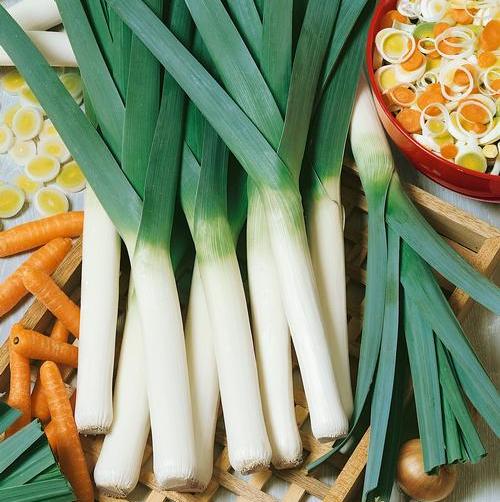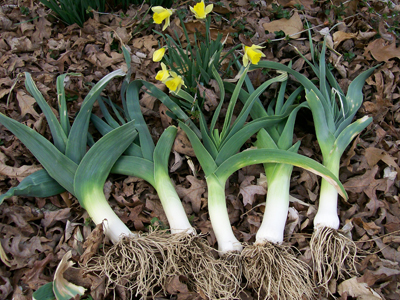
Learning Download: How to Grow Leeks
From Seed to Harvest: A guide to growing leeks.
Similar to an onion but with a sweeter flavor, leeks make a great addition to salads and soups. The vegetable is hardy and can often be grown in cooler climates.
To plant:
Leeks are easy to grow, but they do take time. Start indoors eight to 10 weeks before the last frost dates and sow seeds 1/4 inch deep and 1/2 inch apart in flats. Around the last frost date, transplant them outside and plant them 4 to 8 inches deep and 4 to 6 inches apart in rows set 20 inches apart. Plant so only a few inches of the leaves show above the soil. To sow outdoors directly, plant four weeks before the last frost. pLant seeds 1.2 inch deep and 1 inch apart in rows set 20 inches apart. When growth occurs, thin to 4 to 6 inches.
To grow:
Leeks do best in soils with a pH of 6.2 to 6.8. grow leeks near carrots, celery, beets and onions. Do not plant them near beans and peas. Provide plentiful, even watering for a better crop. Since leeks have shallow roots, they require lots of water and a weed-free environment. Add mulch to retain moisture and deter weeds.
To harvest
Leeks are ready to harvest in the late summer or early fall, and the whole plant should be harvested. To harvest, loosen the soil and then lift the leeks out by the roots so you don’t damage the plant. Pick what you need until a freeze is suspected to hit, then harvest all the leeks.
What leeks crave:
Leeks like fertile soil. Add 1/2 cup of organic fertilizer or compost when planting. A season prior to planting, add compost where the leeks will grow. After planting, feed the leeks every week with liquid fertilizer.
Where to buy leek seeds:
You can find leek seeds at Urban Farmer.
Learning Download: Common pests and diseases: Leeks
Common pests and diseases: Leeks
When growing vegetables, it is always exciting to care for the plant throughout its growing phase and then harvest it for delicious recipes later on, but one thing to watch out for is pests and diseases. Different plants are susceptible to different types of pests and diseases, and it is important to make yourself aware so you can keep a watchful eye and take any preventative methods to keep your plants safe throughout their lifespan.
Leeks can fall victim to several different pests and diseases.
Pests:
Some of the common pests affecting leeks are leafminers, thrips and onion maggots.
Leafminers can create white splotches on the leaves and the leaves will fall off the plant. If the leafminers infect the plant when it is young, it can reduce the pant’s yield. Remove plant debris from the soil immediately after harvest to prevent this, and use insecticides once the damage is identified.
Thrips will create discolored leaves and scarring, and affected plants may look silver in color. To prevent this, don’t plant leeks or onion-related plants near grain fields. Overhead watering may help reduce the thrips. Apply insecticides once you identify the damage as that of a thrip.
Onion maggots will cause seedlings to be stunted or wilted. IF the infestation occurs while the leeks are in their bulbing phase, the bulbs will appear deformed and be susceptible to storage rot after harvest. The onion maggot is a gray-colored fly that lays eggs around the base of the plant. The larvae, which come from the eggs, will bore into the leeks. To prevent onion maggots, clean up all debris after harvest, and apply granular insecticides if necessary. Remove any wild onion or chives, because these can act as an infection source. Utilize floating row covers.
Diseases:
Some of the diseases affecting leeks include Botrytis leaf blight, damping-off, pink root and more.
Botrytis leaf blight is a fungus that will create small, white lesions with green halos. Leaves may blight if moisture is prevalent for a long time. The disease prefers high humidity and warm temperatures, and the fungus survives on crop debris or in the soil. Older leaves are more susceptible to blight. To prevent this disease, plant the leeks with enough space in between them to allow for good air circulation. Apply fungicides when needed.
Damping-off will cause the seeds to rot, and there will be discolored root tips. The disease prefers moist or wet soil, and the best way to prevent this disease from occurring is to plant only disease-free seed and tread the seed with fungicides. You can also practice crop rotation.
Pink root causes light pink roots that can turn purple, become transparent and then appear water soaked. Infected seedlings may die, or the plant may look like it has a nutrient deficiency. To prevent this disease, practice good crop rotation and utilize solarization to reduce the pathogen levels in the soil.


